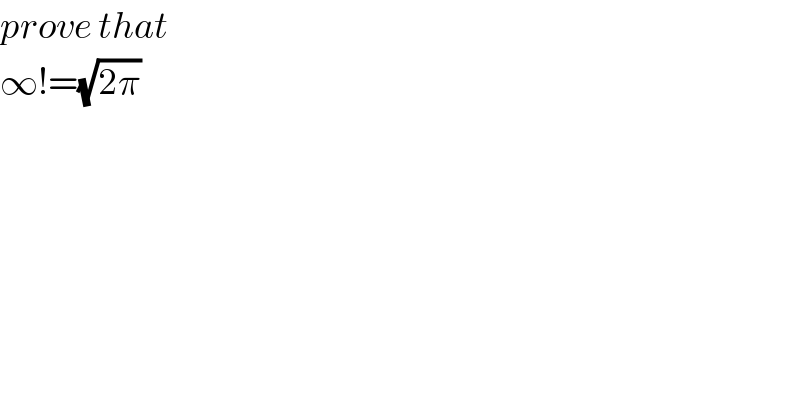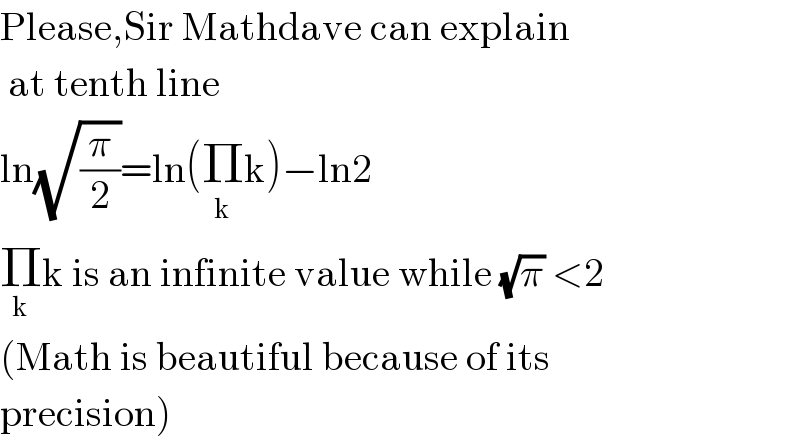
Question and Answers Forum
Question Number 112655 by mathdave last updated on 09/Sep/20

Commented by MJS_new last updated on 09/Sep/20

Commented by mathdave last updated on 09/Sep/20

Answered by mathdave last updated on 09/Sep/20
![solution since η(s)=Σ_(k=1) ^∞ (−1)^(k+1) k^(−s) =(1−2^(1−s) )ζ(s) η^′ (s)=Σ_(k=1) ^∞ (−1)^k ((lnk)/k^s )=ζ^′ (s)(1−2^(1−s) )+ζ(s)2ln2 η^′ (0)=Σ_(k=1) ^∞ (−1)^k lnk=−ln(1)+ln(2)−ln(3)+−−−− η^′ (0)=ln((π/2))−η^′ (0)[walli′s product] η^′ (0)=(1/2)ln((π/2))=ln((√(π/2))).........(1) again η^′ (0)=−ζ^′ (0)+ζ(0)2ln2=−[η^′ (0)−ln(π)]−ln2 2η^′ (0)=ln((π/2)) η^′ (0)=(1/2)ln((π/2))=ln((√(π/2))).........(2) but ln((√(π/2)))=ln(Π_(k=1) k)−ln2 ln((√(π/2)))=ln(∞!)−ln2 ln(∞!)=ln2+ln((√(π/2))) ln(∞!)=ln (2(√(π/2)))=ln((√(2π))) ln(∞!)=ln((√(2π))) ∵ ∞!=(√(2π)) Q.E.D by mathdave(09/09/2020)](Q112698.png)
Commented by Her_Majesty last updated on 09/Sep/20
![show that X^(⟨7⟩) ⇒^! (X−1)^(⟨−3⟩) proof: X^7 ⊂X^(⟨7∣−9⟩) ⊃(X+1)^(⟨−3∣−5∣=7⟩) but (X+1)^(⟨−3∣−5∣=7⟩) =(X−5)^(⟨−3∣−5∣=7⟩) and (X−5)^(⟨−3∣−5∣=7⟩) ⊂(X−6)^(⟨7∣−9⟩) ⊃(X−6)^(⟨7⟩) but we know (x+u) ⇒^! (x+v) ⇔ v= { ((u+5)),((u−7)) :} (Beck−Runnel−Axiom) ⇒ (x−6) ⇒^! (x−1) ⇒ ⇒ (X−6)^(⟨7⟩) ⇒^! (X−1)^(⟨−3⟩) but we have shown (X−6)^(⟨7⟩) ⊂(X−6)^(⟨7∣−9⟩) ⊃(X−5)^(⟨−3∣−5∣−^(2o) 7⟩) = =(X+1)^(⟨−3∣−5∣=7⟩) ⊂X^(⟨7∣−9⟩) ⊃X^(⟨7⟩) ⇒ ⇒ X^(⟨7⟩) ⇒^! (X−1)^(⟨−3⟩) q.e.d. [b.t.w. because of the Axioms of Inversion (X+u)^(⟨−3∣7⟩) =(X+v)^(⟨6⟩) with v= { ((u+3)),((u−9)) :} we also showed that X^(⟨7⟩) ⇒^! (X+2) which is essential to Simon′s Approach]](Q112718.png)
Commented by Her_Majesty last updated on 09/Sep/20
![(1) find all possible sources of (X−1)^(⟨+5⟩) [super easy] (2) find possible sources of (a) (X−3)^(⟨+5∣−7⟩) and (b) (X+4)^(⟨−5∣−7⟩) and their center angles [hard]](Q112722.png)
Commented by MJS_new last updated on 09/Sep/20

Commented by 1549442205PVT last updated on 09/Sep/20

Commented by Tawa11 last updated on 06/Sep/21

